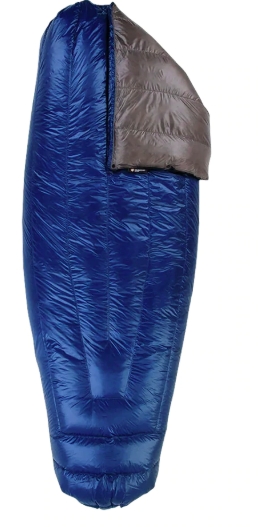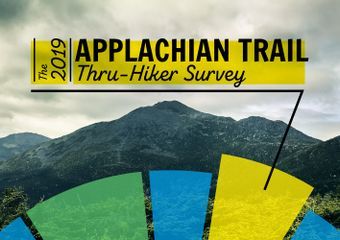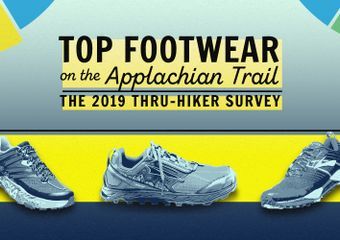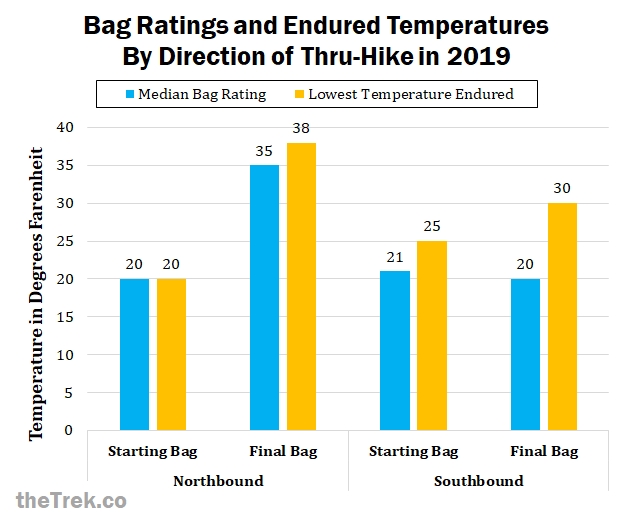Top Sleeping Bags and Pads: The 2019 Appalachian Trail Thru-Hiker Survey
In 2019, we surveyed 365 section and thru-hikers who were on the Appalachian Trail (AT) . We asked these hikers about the sleeping bags they used, as well as quilts and sleeping pads. We also looked at our data over time and noticed a trend that’s becoming more popular each year. For the details, keep reading—otherwise skip to the TL;DR at the end.
For more details on the hiker demographics, check out our post with general information from the survey.
Sleeping Bags and Backpacking Quilts
When looking at the preferred type of sleeping bag, most hikers (70%) opted for the traditional sleeping bag, but backpacking quilts were also fairly popular, being used by at least one third (33%) of hikers. One thru-hiker used a down blanket and no hikers went without sleep insulation. Regarding the hikers who carried both a quilt and a bag, this is somewhat common for hikers using hammocks, especially on trails like the AT where they might use a regular bag when sleeping in a lean-to shelter.
Quilts have typically been used in conjunction with hammocks, and hammockers were significantly more likely to use quilts and significantly less likely to use sleeping bags. However, as in 2018, we saw about a quarter (24.5%) of traditional tent users choosing quilts.1
While the quilt trend declined slightly since 2017 for tent users, we’ve continued to see an overall upward trend in quilts becoming increasingly popular for hammock users.
Related: The Best Sleeping Bags for Backpackers
*Note: Enlightened Equipment ranks as the #1 brand, even though quilts make up the minority of overall models in the survey. This can be attributed to the fact that Enlightened Equipment has a large percentage of market share for backpacking quilts, while sleeping bag models are spread between a greater variety of brands.
Switching and Replacements
About one third of hikers (35.6%) used more than one sleeping bag during their hike. In past years, they have typically kept the same type of bag (quilt vs. traditional) and the same fill type, so we did not ask follow-up questions about that this year. Changes are usually on the level of choosing different models, or seasonal changes to bags of different temperature ratings.
Insulation
 Next, we asked hikers about the type of insulation/fill in the primary bag or quilt they used on their AT hike in 2019. While natural down, synthetic, and both were all fairly popular choices, natural down was the most common, used by almost half of hikers. Regarding the “mixed” category, a few hikers used bags that were synthetic on one side but natural down on the other. Similarly, some used a synthetic underquilt with a down overquilt or vice versa. The concept for this combination is to have the water-resistant feature of synthetic fill on the bottom side (which would become damp more easily on the ground), but the warmth and lighter weight of natural down on the top. For quilt users with the reverse, the combination may have been for other reason, such as cost or weight.
Next, we asked hikers about the type of insulation/fill in the primary bag or quilt they used on their AT hike in 2019. While natural down, synthetic, and both were all fairly popular choices, natural down was the most common, used by almost half of hikers. Regarding the “mixed” category, a few hikers used bags that were synthetic on one side but natural down on the other. Similarly, some used a synthetic underquilt with a down overquilt or vice versa. The concept for this combination is to have the water-resistant feature of synthetic fill on the bottom side (which would become damp more easily on the ground), but the warmth and lighter weight of natural down on the top. For quilt users with the reverse, the combination may have been for other reason, such as cost or weight.
Temperature Ratings
We asked hikers the temperature rating of the bag (or quilt) they started out using and the lowest temperature they endured with that bag. We asked the same questions about the final bag they used. Because the optimal temperature ratings are expected to change by season, I broke these numbers down for northbound thru-hikers and southbound thru-hikers. Unfortunately, we don’t have enough data on flip-floppers of each direction to give good averages for these.
Northbounders
For northbounders, with the bag/quilt they used the majority of their hike, the median lowest temperature endured was 20⁰F. 20 degrees was also the median temperature rating of their bags/quilts. For northbounders who switched out their bag/quilt, their final bags had a median temperature rating of 35⁰F, and the median temperature they endured with this bag was 38⁰F. Future northbound hikers, be aware that temperatures fluctuate each year. The 25 percent of hikers who endured the lowest temperatures faced lows from -15⁰F to 15⁰F. The key takeaway I would recommend is that northbounders starting with the bubble should probably use bags rated from 15 to 20⁰F. Hikers starting any earlier will want lower bag ratings since the temperatures might be much colder. Northbounders who replace their bags in the warmer months are probably fine with a bag rated around 35⁰F to 40⁰F.
Southbounders
For southbounders, the median lowest temperature they endured was 20⁰F and the median bag/quilt rating was 20⁰F. Southbounders who switched out their bags said the lowest temperature they endured with their second bag was, on average, 30⁰F, and the median temperature rating for the second bag was still 20⁰F. The key takeaway I recommend is that most southbounders should still use a 20⁰F bag, which will likely be sufficient for the entirety of the hike. Hikers who start southbound particularly late should get a warmer bag as they could face temperatures as low as 0 degrees toward the end of the hike.
Sleeping Pads
Overall, three-quarters of hikers (74.6%) used an inflatable sleeping pad, about 17 percent used a foam pad, 3 percent used a pad that has both some foam and some inflation, and 5 percent did not use a pad at all. Compared to hikers using any other shelter system, hammock users had a strong preference for foam pads, although more hammock users chose inflatable pads compared to previous years.
Most Popular Brands and Models
We asked hikers what their favorite bag or quilt was that they used on the Appalachian Trail in 2019. In order of brand popularity, their favorite brands and models were:
-
Enlightened Equipment (88 hikers’ favorite)

- Revelation (42)
- Enigma (37)
- Convert (5)
-
REI (53)

-
Marmot (23)

- Helium (7)
- Trestles Elite (3)
-
Big Agnes (20)

-
ZPacks (18)

- Classic Sleeping Bag (18)
-
Western Mountaineering (18)

-
Hammock Gear (13)

- Burrow (3)
-
Kelty (11)
-
NEMO (11)
-
Feathered Friends (8)
-
Katabatic (8)
-
Mountain Hardwear (7)
Enlightened Equipment was the most popular brand overall, with their Revelation quilt the most popular model across both quilts and bags. The most popular brand for sleeping bags was REI, with the REI Magma model and Zpacks Classic being the most popular models.
Sleeping Pad Brands and Models
-
Therm-a-Rest (218 hikers’ favorite)

- NeoAir series (127)
- XLite variations (111)
- XTherm (28)
- ZLite series (45)
- UberLite (18)
- NeoAir series (127)
-
Big Agnes (33)

- Q Core SLX (5)
- Air Core series (5)
-
NEMO (32)

- Tensor (21)
-
Sea to Summit (26)

- Ultralight Air (5)
-
Klymit (13)

- Static V (8)
The most popular sleeping pad brand was Therm-a-Rest, preferred by about two-thirds of hikers in the survey. The Therm-a-Rest NeoAir XLite pad and the ZLite pads were the most popular models.
TL;DR
- Synthetic, natural down, and treated down bags are all common choices among long-distance hikers on the AT, with down bags being the most common.
- The majority of long-distance hikers continue to use the traditional sleeping bag, even among those with non-traditional shelters. However, we’ve seen a trend over time, where quilt systems have increased in popularity among tent users and even more popular with hammock-users.
- For northbounders, a temperature rating of 20 F is probably sufficient for the typical thru-hiker. Those starting early (or earlier than the bubble) should consider ratings as low as 10 F or less.
- Northbounders who replace their bags seasonally should be fine, on average, with summer bags rated at 30 to 40 F.
- For southbounders, a bag rated 20 F is likely sufficient.
- Inflatable pads are preferred by most hikers; hikers using hammocks are more likely to use foam pads but increasingly use inflatable (some hammock models include a sleeve for inflatable pads, and many hikers choose sleeping gear that will work for the lean-tos as well).
- This year, Enlightened Equipment quilts overtook REI bags as the most popular brand for bags/quilts.
- REI remains the most popular brand of sleeping bags used by AT hikers, and the Magma is the most popular REI model.
- The most popular Enlightened Equipment models were the Revelation quilt and Enigma quilt.
- Nearly two-thirds of hikers used Therm-a-Rest sleeping pads, and the vast majority of those hikers used variations of the NeoAir XLite pad.
Many Thanks!
Congratulations to all hikers who completed the entire AT or a section in 2019! Many thanks to those who participated in the survey. Thanks also to Zach Davis and Maggie Slepian for their helpful input and for distributing the survey.
More from the 2019 Survey
Check out our earlier posts on general hiker information, footwear, and tents/shelter systems. Be on the lookout for the next two posts on backpacks and on stoves/food/water. For the upcoming gear survey posts, subscribe to the Trek Newsletter.
Notes for the nerds
Chi-Sq. = 55.02, df = 5, p < .001.
This website contains affiliate links, which means The Trek may receive a percentage of any product or service you purchase using the links in the articles or advertisements. The buyer pays the same price as they would otherwise, and your purchase helps to support The Trek's ongoing goal to serve you quality backpacking advice and information. Thanks for your support!
To learn more, please visit the About This Site page.










Comments 8
I’m wondering: did any of the uberlite users have comments regarding its longevity or punctures and its warmth? 20F on a 2.0 R value seems like a rather cold idea 😀
Would you please say a few words about temperature rating for the bags? Are you reporting comfort ratings or more like lower limit in your charts and tables?
Great info. Tks